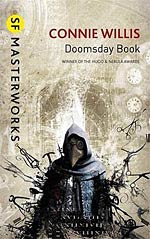
![]() Brett72
Brett72
5/7/2013
![]()
In the 22nd century time travel has become possible, but nature loathes a paradox more than a vacuum. A traveler can attempt to go to any point in the past, but there will be "slippage" as the universe moves the traveler to a time point where they can't wreak havoc with history. Future travel is a non-starter. As a result, time travel is used as a research tool by academia.
The two main characters of the Doomsday Book are Kivrin, a graduate student, and Mr. Dunworthy, a university professor. Kivrin has always wanted to travel to the Middle Ages, but that time period is off-limits due to the danger posed. An ambitious professor seizes his chance during Christmas break, when he is functioning as acting head of the department, opens the Middle Ages and organizes a trip to send Kivrin to England in 1320. Mr. Dunworthy, an expert in the 20th century and Kivrin's former mentor, opposes the trip to no avail. As soon as Kivrin arrives in the past she comes down with a mysterious illness. Back in the 22nd century the tech working the trip falls ill with a similar sickness. The sickness spreads and soon becomes an epidemic, then a pandemic.
The novel follows Kivrin as she attempts to survive the Middle Ages and return to the drop point in time for the return trip and Mr. Dunworthy as he attempts to survive the pandemic, determine if Kivrin's drop went as planned, and open the "net" in time to retrieve her. As Kivrin and Mr. Dunworthy each have no way of knowing what is happening to the other, the Doomsday Book reads like two books. Two related books, sure, but each with its own distinct feel.
The chapters following Kivrin in the Middle Ages are excellent. Her struggles to survive in a foreign world were believable and the relationships she develops heartbreaking. It is undoubtedly these chapters that won the novel a large part of its critical praise.
The chapters following Mr. Dunworthy have almost a sit-com feel. Despite the grim nature of the pandemic, many of the characters are written for comic effect. Perhaps author Connie Willis felt she needed a lighter counterpoint to the dark nature of Kivrin's travails, but the result was jarring.
One other thing that was jarring was the state of communication in the 22nd century. Somewhere along the way mobile communication devices, such as cell phones, were abandoned. Much of the story hinges on people unable to get in contact with certain other people. Mobile phones would have really helped out. The Doomsday Book was first published in 1992. While mobile phones were not in common use when this novel was written, personal communication devices have long been a staple in science-fiction and there absence here detracts from the story.
Overall, I am left with a positive feeling for the Doomsday Book. The story of a time traveler struggling to survive in medieval times was beautifully done and overcame the detractions of the 22nd century plotline.